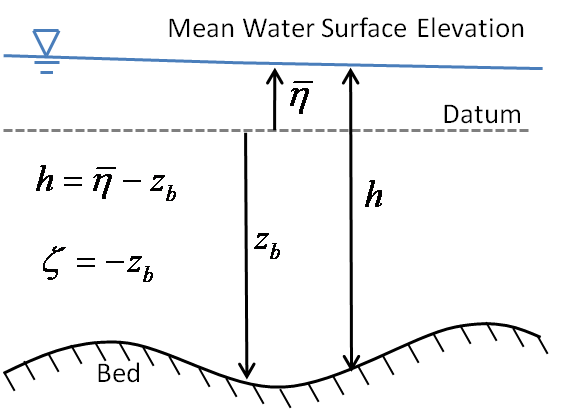CMS-Flow Hydrodnamics: Variable Definitions
Phillips (1977), Mei (1983), and Svendsen (2006) provide a detailed deri-vation of the depth-integrated and wave-averaged hydrodynamic equa-tions. Here, only variable definitions are provided and derivations may be obtained from the preceding references. The instantaneous current velocity ui is split into:
in which
= current (wave-averaged) velocity [m/s]
= wave (oscillatory) velocity with wave-average
= turbulent fluctuation with ensemble average = 0 and wave average = 0 [m/s]
The wave-averaged total volume flux is defined as
=
where
= wave-averaged water depth [m]
= total mean mass flux velocity or simply total flux velocity for short [m/s]
= instantaneous current velocity [m/s]
= instantaneous water level with respect to the Still Water Level (SWL) [m]
= bed elevation with respect to the SWL [m]
For simplicity in the notation, the over bar in subsequent wave-averaged variables is omitted. The total flux velocity is also referred to as the mean transport velocity (Phillips 1977) and mass transport velocity (Mei 1983). The current volume flux is defined as
(2-3)
where is the depth-averaged current velocity. Similarly, the wave volume flux is defined as by
where is the depth-averaged wave flux velocity [m/s], and = wave trough elevation [m]. Therefore the total flux velocity may be written as
On the basis of the above definitions, and assuming depth-uniform cur-rents, the general depth-integrated and wave-averaged continuity and momentum equations may be written as (Phillips 1977; Mei 1983; Svendsen 2006)
(2-6)
(2-7)
where
t = time[s]
= Cartesian coordinate in the direction [m]
= Coriolis parameter [rad/s] where rad/s is the earth’s angular velocity of rotation and is the latitude in degrees
h = wave-averaged total water depth [m]
wave-averaged water surface elevation with respect to refer-ence datum [m]
water source/sink term due to precipitation, evaporation and structures (e.g. culverts) [m/s]
total flux velocity defined as [m/s]
wave- and depth-averaged current velocity [m/s]
mean wave mass flux velocity or wave flux velocity for short [m/s]
gravitational constant (~9.81 m/s2)
atmospheric pressure [Pa]
water density (~1025 kg/m3)
turbulent eddy viscosity [m2/s]
wind surface stress [Pa]
wave radiation stress [Pa]
surface roller stress [Pa]
bed slope coefficient [-]
combined wave and current mean bed shear stress [Pa]
The equations above are similar to those derived by Svendsen (2006), ex-cept for the inclusion of the water source/sink term in the continuity equation and the atmospheric pressure and surface roller terms in the momentum equation. It is also noted that the horizontal mixing term is formulated differently as a function of the total flux velocity, similar to the Generalized Lagrangian Mean (GLM) approach (Andrews and McIntyre 1978; Walstra et al. 2000). This approach is arguably more physically meaningful and also simplifies the discretization.
Figure 2-1 shows the vertical conventions used for mean water surface elevation and bed elevations. The arrows indicate the reference elevation for each variable. Note that the total water depth is always positive.
Figure 2.1 Vertical conventions used for mean water surface elevation and bed elevations.
